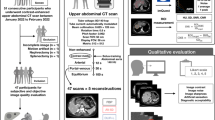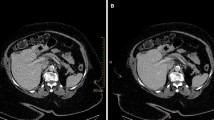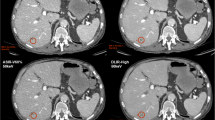Abstract
Objectives
Evaluate a novel algorithm for noise reduction in obese patients using dual-source dual-energy (DE) CT imaging.
Methods
Seventy-nine patients with contrast-enhanced abdominal imaging (54 women; age: 58 ± 14 years; BMI: 39 ± 5 kg/m2, range: 35–62 kg/m2) from seven DECT (SOMATOM Flash or Force) were retrospectively included (01/2019–12/2020). Image domain data were reconstructed with the standard clinical algorithm (ADMIRE/SAFIRE 2), and denoised with a comparison (ME-NLM) and a test algorithm (rank-sparse kernel regression). Contrast-to-noise ratio (CNR) was calculated. Four blinded readers evaluated the same original and denoised images (0 (worst)–100 (best)) in randomized order for perceived image noise, quality, and their comfort making a diagnosis from a table of 80 options. Comparisons between algorithms were performed using paired t-tests and mixed-effects linear modeling.
Results
Average CNR was 5.0 ± 1.9 (original), 31.1 ± 10.3 (comparison; p < 0.001), and 8.9 ± 2.9 (test; p < 0.001). Readers were in good to moderate agreement over perceived image noise (ICC: 0.83), image quality (ICC: 0.71), and diagnostic comfort (ICC: 0.6). Diagnostic accuracy was low across algorithms (accuracy: 66, 63, and 67% (original, comparison, test)). The noise received a mean score of 54, 84, and 66 (p < 0.05); image quality 59, 61, and 65; and the diagnostic comfort 63, 68, and 68, respectively. Quality and comfort scores were not statistically significantly different between algorithms.
Conclusions
The test algorithm produces quantitatively higher image quality than current standard and existing denoising algorithms in obese patients imaged with DECT and readers show a preference for it.
Clinical relevance statement
Accurate diagnosis on CT imaging of obese patients is challenging and denoising algorithms can increase the diagnostic comfort and quantitative image quality. This could lead to better clinical reads.
Key Points
• Improving image quality in DECT imaging of obese patients is important for accurate and confident clinical reads, which may be aided by novel denoising algorithms using image domain data.
• Accurate diagnosis on CT imaging of obese patients is especially challenging and denoising algorithms can increase quantitative and qualitative image quality.
• Image domain algorithms can generalize well and can be implemented at other institutions.






Similar content being viewed by others
Abbreviations
- BMI:
-
Body mass index
- CIPG:
-
Clinical Imaging Physics Group
- CNR:
-
Contrast-to-noise ratio
- DECT:
-
Dual-energy CT
- ICC:
-
Intraclass correlation
- kVp:
-
Kilovolt peak
- MAD:
-
Median absolute deviation
- ME-NLM:
-
Multi-Energy Non-Local Means
- MTF:
-
Modulation transfer function
- NPS:
-
Noise power spectrum
- PACS:
-
Picture archiving and communication system
- ROI:
-
Region of interest
- RSKR:
-
Rank sparse kernel regression
- SD:
-
Standard deviation
- sec:
-
Second
References
Megibow AJ, Sahani D (2012) Best practice: implementation and use of abdominal dual-energy CT in routine patient care. AJR Am J Roentgenol 199:S71–S77
Modica MJ, Kanal KM, Gunn ML (2011) The obese emergency patient: imaging challenges and solutions. Radiographics 31:811–823
Uppot RN (2018) Technical challenges of imaging & image-guided interventions in obese patients. Br J Radiol 91:20170931
Rubin GD (2000) Data explosion: the challenge of multidetector-row CT. Eur J Radiol 36:74–80
Langer SG (2011) Challenges for data storage in medical imaging research. J Digit Imaging 24:203–207
Mileto A, Guimaraes LS, McCollough CH, Fletcher JG, Yu L (2019) State of the art in abdominal CT: the limits of iterative reconstruction algorithms. Radiology 293:491–503
Clark DP, Badea CT (2017) Hybrid spectral CT reconstruction. PLoS One 12
Li Z, Yu L, Trzasko JD et al (2014) Adaptive nonlocal means filtering based on local noise level for CT denoising. Med Phys 41:011908
Li Z, Leng S, Yu L, Manduca A, McCollough CH (2017) An effective noise reduction method for multi-energy CT images that exploit spatio-spectral features. Med Phys 44:1610–1623
Greffier J, Frandon J, Larbi A, Beregi J, Pereira F (2020) CT iterative reconstruction algorithms: a task-based image quality assessment. Eur Radiol 30:487–500
Jaffe TA, Martin LC, Miller CM et al (2007) Abdominal pain: coronal reformations from isotropic voxels with 16-section CT–reader lesion detection and interpretation time. Radiology 242:175–181
Steuwe A, Weber M, Bethge OT et al (2021) Influence of a novel deep-learning based reconstruction software on the objective and subjective image quality in low-dose abdominal computed tomography. Br J Radiol 94:20200677
Mohammadinejad P, Mileto A, Yu L et al (2021) CT noise-reduction methods for lower-dose scanning: strengths and weaknesses of iterative reconstruction algorithms and new techniques. Radiographics 41:1493–1508
Geyer LL, Schoepf UJ, Meinel FG et al (2015) State of the art: iterative CT reconstruction techniques. Radiology 276:339–357
Carney PA, Bogart TA, Geller BM et al (2012) Association between time spent interpreting, level of confidence, and accuracy of screening mammography. AJR Am J Roentgenol 198:970–978
Willatt JMG, Mason AC (2006) Comparison of radiology residency programs in ten countries. Eur Radiol 16:437–444
Homayounieh F, Holmberg O, Umairi RA et al (2021) Variations in CT utilization, protocols, and radiation doses in COVID-19 pneumonia: results from 28 countries in the IAEA Study. Radiology 298:E141–E151
Taylor-Phillips S, Stinton C (2019) Fatigue in radiology: a fertile area for future research. Br J Radiol 92:20190043
Badea CT, Clark DP, Holbrook M, Srivastava M, Mowery Y, Ghaghada KB (2019) Functional imaging of tumor vasculature using iodine and gadolinium-based nanoparticle contrast agents: a comparison of spectral micro-CT using energy integrating and photon counting detectors. Phys Med Biol 64:065007
Acknowledgements
This project was made possible by a collaborative research agreement with Siemens Healthineers (Erlangen, Germany). We would like to thank the Duke Clinical Imaging Physics Group under Dr. Samei for their support in identifying patients eligible for our study.
Funding
This study has received funding by the NIH National Cancer Institute (U24 CA220245, R01 CA196667 and RF1AG070149-01).
Author information
Authors and Affiliations
Corresponding author
Ethics declarations
Guarantor
The scientific guarantor of this publication is Daniele Marin.
Conflict of interest
Fides R. Schwartz and Daniele Marin – speaker honoraria from Siemens Healthineers.
Fides R. Schwartz is a member of the European Radiology Editorial Board. They have not taken part in the review or selection process of this article.
The other authors of this manuscript declare no relationships with any companies whose products or services may be related to the subject matter of the article.
Statistics and biometry
No complex statistical methods were necessary for this paper.
Informed consent
This was a retrospective study and the IRB waived the need for informed consent from individual patients. No animal subjects were studied.
Ethical approval
Institutional Review Board approval was obtained prior to the start of the study.
Methodology
• retrospective
• cross-sectional
• performed at one institution
Additional information
Publisher's note
Springer Nature remains neutral with regard to jurisdictional claims in published maps and institutional affiliations.
Fides R. Schwartz and Darin P. Clark share co-first authorship.
Supplementary Information
Below is the link to the electronic supplementary material.
Rights and permissions
Springer Nature or its licensor (e.g. a society or other partner) holds exclusive rights to this article under a publishing agreement with the author(s) or other rightsholder(s); author self-archiving of the accepted manuscript version of this article is solely governed by the terms of such publishing agreement and applicable law.
About this article
Cite this article
Schwartz, F.R., Clark, D.P., Rigiroli, F. et al. Evaluation of the impact of a novel denoising algorithm on image quality in dual-energy abdominal CT of obese patients. Eur Radiol 33, 7056–7065 (2023). https://doi.org/10.1007/s00330-023-09644-7
Received:
Revised:
Accepted:
Published:
Issue Date:
DOI: https://doi.org/10.1007/s00330-023-09644-7




